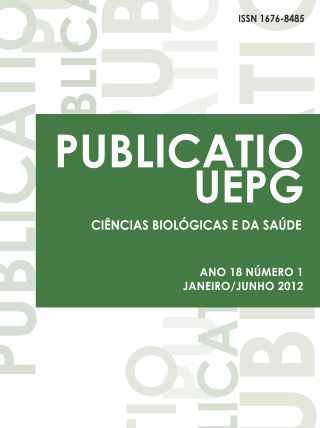Tracionamento radicular estético ao alcance do Cirurgião-dentista clínico geral. Aesthetic traction root within reach of the surgeon General dentist.
DOI:
https://doi.org/10.5212/publicatio%20uepg.v18i1.4690Palabras clave:
Fraturas dos dentes, Tração, Raiz dentária, Movimentação dentária.Resumen
RESUMO
Para o sucesso de qualquer procedimento restaurador estético que envolva reabilitação protética, é necessário que a distância entre o término cervical e a crista óssea seja mantida. Com o objetivo de melhorar a relação prótese e região periodontal essa distância deve ser respeitada. A união dento-gengival quando rompida não fornecerá adequada união dos hemidesmossomos epiteliais, propiciando o aparecimento de problemas inflmatórios. Baseado no princípio de manutenção dessas distâncias para preservação deste epitélio a fi m de evitar possíveis infl amações, o tracionamento radicular torna-se uma alternativa de tratamento capaz de reabilitar dentes fraturados transversalmente abaixo no nível ósseo, perfurações laterais de raiz, cáries subgengivais, diminuição de defeitos intraósseos, nivelamento de margens gengivais, reabsorções radiculares cervicais e preparo local de implantes que irão substituir dentes condenados periodontalmente desde que haja quantidade sufi ciente de raiz dental capaz de suportar a posterior reabilitação protética. O presente artigo apresenta um caso de fratura de canino onde foi utilizado o tracionamento radicular para restabelecer as distâncias biológicas corretas para posterior confecção de coroa protética.
Palavras-chave: Fraturas dos dentes. Tração. Raiz dentária. Movimentação dentária.
Ortodontia. Prótese periodontal.
ABSTRACT: For the success of any aesthetic restorative procedure involving prosthetic rehabilitation, it is necessary that the distance between the cervical end and the bone crest is maintained. Aiming to improve the relationship between the periodontal region and the prosthesis this distance must be respected. When the dentogingival junction is broken it does not provide an adequate union of the epithelial hemidesmosomes, resulting in inflamatory conditions. Based on the principle of maintaining such lengths to preserve the epithelium to avoid possible infl ammation, root traction becomes an alternative treatment capable of restoring transversely fractured teeth, below the bone level, lateral root perforationns, subgingival caries, decreased of intrabony defects, leveling the gingival margins, cervical root resorption and implant site preparation, which will replace periodontally affected teeth once there is enough tooth root to withstand the subsequent prosthetic rehabilitation. This article presents a case of fracture of canine where traction was used to restore the correct biological distances so that a prosthetic crown could be used.
Keywords: Tooth fractures. Traction. Tooth root. Tooth movement. Orthodontics. Periprosthetic fractures.
Descargas
Descargas
Número
Sección
Licencia

Este obra está licenciado com uma Licença Creative Commons Atribuição 4.0 Internacional.
Esta licença permite que outros distribuam, remixem, adaptem e criem a partir do seu trabalho, mesmo para fins comerciais, desde que lhe atribuam o devido crédito pela criação original. Este posicionamento está de acordo com as recomendações de acesso aberto da Budapest Open Access Initiative (BOAI).


